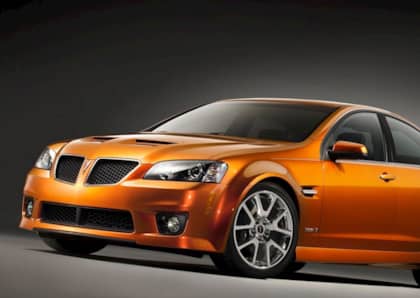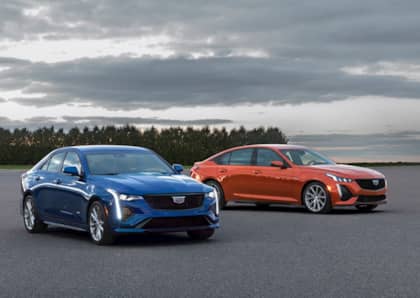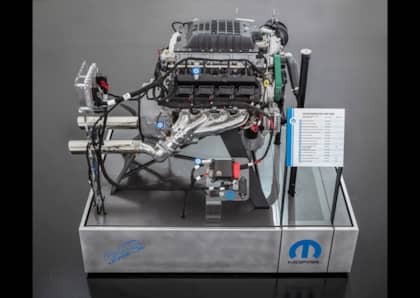The Cadillac Allante and Chrysler TC by Maserati: Detroit Luxury's '80s-Era Swan Song
It's a tale of hubris and tragedy that couldn't have better illustrated the state of the American auto industry at the tail end of the '80s if it had been scripted by the Bard himself. Cadillac and Chrysler, one on the verge of cultural irrelevance and the other feeling itself out after a string of high-profile acquisitions, each overstepped their station in life in the pursuit of a customer that simply didn't exist anywhere near their respective showrooms.
Not only that, but each company chased after this well-heeled phantom with a product that was not only wildly out of step with the state of the luxury market, but also fantastically expensive to build, and ultimately financially ruinous to all involved. The stories of the Chrysler TC by Maserati and Cadillac Allante may have been born of two very different automotive cultures, but the parallels between their not-quite rise and precipitous fall are undeniable.
Italian Cousins
Both the Allante and the TC by Maserati were designed and manufactured in Italy, an unusual decision for a pair of mass-market auto companies to make, and one that stemmed from two different places.
On Cadillac's side, it was presented as somewhat of a necessity. The company was dealing with the loss of yet another Fisher Body Plant that had served it for decades, and given that the Turin-based Pininfarina would be penning the Allante's lines, the twisted corporate logic at General Motors dictated that they should sculpt the sheet metal in Europe and then fly it over in specially-equipped Boeing 747 airliners for final assembly in Hamtramck, Michigan. Dubbed "The Allante Airbridge," the total cost of the arrangement with Alitalia and Lufthansa was reported to be $100 million, with 56 car bodies moved per flight at a rate of three flights per week.

From a modern perspective, flashing that much cash merely to transport what was destined to be, even in the best case scenario, a low-volume luxury car seems abjectly insane. At the time, however, Cadillac celebrated the expenditure as though it would somehow work to build the Allante's "lore" and help establish the yet-to-be-introduced vehicle as a player in the minds of premium customers.
The TC's Italian turn came about after Chrysler's '80s buying spree saw it pick up a stake in Maserati in 1984 (with controlling interest in Lamborghini three years later). Chrysler's CEO at the time, Lee Iaccoca, had long had a relationship with Maserati's owner Alejandro de Tomaso, dating back to when the two collaborated on the Pantera while Iaccoca was at Ford. The pair decided that it would be a good idea to collaborate on a upscale automobile.
At the time, Iaccoca clearly felt that the Chrysler brand still resonated with wealthy customers, a position that had been badly eroded by years of sub-par models that clung to '70s-era definitions of luxury (velour seats, pillow-soft suspensions), rather than the precision-built, smooth-driving and sporty offerings from Mercedes-Benz and Jaguar that were increasingly dominating the market. Again, hindsight shudders at the juxtaposition of the Pentastar against the Silver Star, but it was full-steam-ahead for the Chrysler-Maserati partnership.
Humble Origins, Modest Results
Both the Cadillac Allante and the Chrysler TC (Turbo Convertible) by Maserati were aimed at the same market segment, but took different mechanical roads to get there. Although each was a full-size convertible, Chrysler chose a modified K-car platform that it labeled the "Q-body" for the front-wheel drive TC, and for the initial 1989 model year they stuffed a turbocharged four-cylinder engine good for about 174hp (plucked from the Dodge Daytona) under the hood. Those who chose to swap in a manual transmission in place of the three-speed automatic (a mere 500 buyers) were gifted with another 40hp by way of a Maserati-built, 16-valve version of the same motor.

Cadillac, on the other hand, doubled the number of cylinders in the Allante by using a 4.1L V8 to start the project in 1987. The 170hp unit sideways-straddled a truncated version of the Eldorado platform called the V-body—the only application of this particular chassis. A four-speed automatic was the only available transmission.
If you're having trouble getting excited about a large luxo-barge with a sub-200hp turbo four and styling that could be labeled neutral at best, you're not alone. Further compounding the lack of TC curb appeal was the fact that the car hit the market after the Chrysler LeBaron, a vehicle that cost significantly less yet offered a similar design. To help further differentiate the sort-of Maserati, Chrysler installed a Mitsubishi-sourced V6 for the 1990-1991 model years that was actually 20hp less powerful than the turbo, an unusual move whose detriment to performance wasn't mitigated whatsoever by the introduction of a four-speed autobox.
World-whimpering power wasn't helped by an interior that had difficulty challenging its would-be European competition. Following an initial flurry of interest in which just under 4,000 were sold, a mere 7,000 total were produced before the project was canned after a three year run. It didn't help that the $35,000 initial price tag (close to $70k in today's dollars) continued to escalate despite flagging power.

Cadillac, for its part, made a valiant effort to continuously improve the Allante throughout its also-short lifespan, punching the engine out to 4.5L in 1989 (for a total of 200hp) and then swapping in a 295hp, 4.6L Northstar V8 for the final 1993 model. The company also loaded the Allante with an exuberant level of "maybe it works, maybe it doesn't" late-'80s/early-'90s technology, including speed-sensitive automatically-adjustable shocks and an advanced security system.
Like the TC, the Allante was also offered with both a removable hardtop and a manual soft top. However, unlike the Chrysler, the Cadillac leaked—badly. It was a known issue that Cadillac chose largely to ignore, which isn't exactly a best practice when targeting vehicles like the SL and the Jaguar XJS. It's even worse when pricing your car at an aspirational $56,000 (well over $100,000 today), a price tag completely unsupported by their brand position and totally out place compared to the sticker on other vehicles in the same showroom.
The likelihood that Cadillac made any money at all on the Allante is further thrown into question when considering that a series of expensive recalls cost the automaker thousands per car. In all honesty, GM was probably grateful that only 21,430 examples were sold across its seven year lifespan.
Lessons Learned
Both the Allante and the TC have come to serve as cautionary tales for auto execs tempted to see just how far their reach extends past their grasp. There's no question that even the technologically-advanced Cadillac was a project that had no place in the market at the time, with luxury interest shifting to imports and a recession lurking on the horizon.

Punching above one's weight has become much more rare in the industry—see the Volkswagen Phaeton for the most recent faux-pas—and brand building has come to be seen as more than just stamping a price sticker on the window and hoping badge nostalgia will carry the day. Just as the upstart Acura, Infiniti and Lexus efforts would come to underline the right way to expand into the luxury space, the TC and the Allante will continue to mark the graves of those who relied more on faith and pride than research and engineering.











